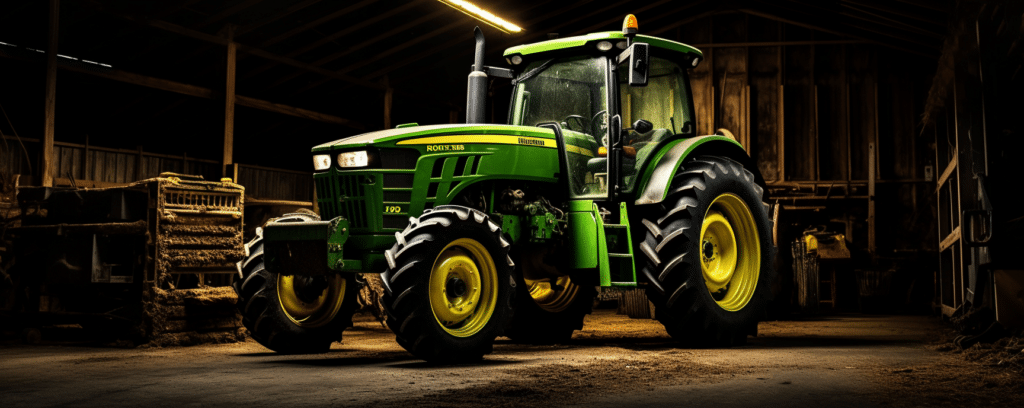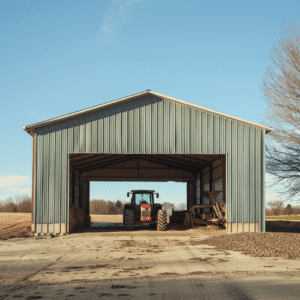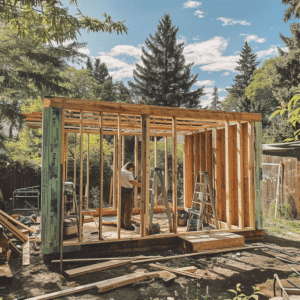Top Tractor Shed Ideas: Innovative Designs for Your Farm Equipment Storage
Last updated Monday, March 4th, 2024

In need of tractor shed ideas fit for your equipment and conditions? This guide outlines how to select dimensions, materials, and layouts that ensure your tractor shed is as robust as it is smartly spaced. Expect no-nonsense advice on building a shed tailored to your needs without compromising on style or substance.
Key Takeaways
- Proper planning of a tractor shed involves determining the right dimensions tailored to specific equipment sizes, selecting durable materials for construction (steel or wood), and strategizing the layout for optimal space utilization and potential future expansions.
- Functional tractor shed design includes considerations such as door design and placement for equipment movement, as well as ventilation and insulation solutions to maintain an energy-efficient environment and enhance usability.
- Enhancing a tractor shed includes a strong foundation that withstands weight and weather, with the perfect location that complies with local regulations and provides easy access. Additionally, customization options for efficiency and security, alongside aesthetic enhancements, can increase functionality and appeal.
Whether it's storage or an extra space to build things in, we're shed builders that make the most of your backyard space with a high-quality, long-lasting and durable shed or garage.
Designing Your Ideal Tractor Shed
Designing your ideal tractor shed is akin to tailoring a bespoke suit. The trick lies in the details: the right dimensions, the perfect materials, and the most effective layout configurations. Just as the perfect suit should not only fit impeccably but also withstand the test of time, your tractor shed should provide ample space for your equipment and stand strong against harsh weather conditions.
We’ll focus on three primary elements while discussing specifics:
- Defining suitable dimensions for your tractor shed
- Choosing materials that ensure durability and protection
- Strategizing the layout for optimal space utilization
Each of these elements plays a pivotal role in creating a durable and functional tractor shed.
Determining the Right Dimensions
In the farming world, one size does not fit all. The dimensions of your tractor shed should be in sync with the specific sizes of your equipment. For instance, a standard tractor or an ATV would typically require a shed measuring around 16×24 feet. But the dimensions don’t stop at the size of your machinery.
Consider the following dimensions when designing your tractor shed:
- Width of a loader bucket or the length of a combine harvester: These critical dimensions influence the necessary spacing within the shed to ensure adequate maneuverability.
- Additional space for easy access for maintenance and storage for implements and supplies.
- Height, width, and depth should be considered when defining the correct measurements for your tractor shed.
Material Selection for Longevity and Protection

Steel tractor barns, especially those made of robust steel, are a formidable choice. They offer unmatched durability and weather resistance, safeguarding your machinery even in severe weather. On the other hand, wooden tractor barns, such as pole barns, provide a cost-effective and simpler construction alternative, with a lower initial investment than their steel counterparts. However, while wood offers natural ventilation and economical benefits, it demands more maintenance over time compared to a steel tractor barn.
Ultimately, the decision between steel and wood is dictated by your unique needs and preferences.
Layout Configurations to Maximize Space
Designing the layout of your tractor shed is much like arranging pieces on a chessboard. Each move should be strategic and aimed at optimizing space and functionality. There are various configurations to consider, each with its unique advantages.
An open-front, three-sided shed configuration offers versatility in storage and future use since one of the long sides is left open. Drive-through configurations, on the other hand, provide wide access and eliminate obstructions at the rear of the shed, facilitating the full use of shed length. You could even consider dedicating an area within the shed to serve as a workshop, or include cantilevered canopies for cost-effective additional storage space. The strategy lies in considering not only your current requirements but also potential future extensions.
Essential Features of a Functional Tractor Shed
Several prominent features can augment the usability of your tractor shed during its design phase. Door design and placement, as well as ventilation and insulation solutions, play a significant role in the overall functionality of your shed.
Take the door design, for example. A well-placed large door, such as a double door or an overhead door, can greatly facilitate the movement of machinery into and out of the shed. Similarly, the right ventilation and insulation solutions can maintain a comfortable and energy-efficient environment in your tractor shed.
Let’s explore these two vital facets of tractor shed design further.
Door Design and Placement
Door design and placement in a tractor shed can greatly influence its functionality. From sliding doors used in fully-enclosed or open-front machinery sheds to bi-fold doors suitable for large farm equipment access, the options are influenced by factors such as access needs and the absence of power for operation.
The placement of the door should consider workflow efficiency and environmental factors. For instance, north-facing doors might be colder, while south and west-side doors might experience increased wind. Carefully strategizing door design and placement can enhance your tractor shed’s efficiency.
Ventilation and Insulation Solutions
In any tractor shed, proper ventilation and insulation are crucial for maintaining a comfortable and energy-efficient environment. Insulation in agricultural buildings is critical for conserving energy, leading to significant cost savings by reducing the energy needed for heating, ventilation, and air conditioning systems.
The selection of insulation material, such as fiberglass, foam board, and reflective insulation, depends on the shed’s requirements and the local climate. Similarly, ventilation is facilitated through features like vented ridge caps, which allow proper air circulation while preventing the ingress of pests and rain.
Giving due attention to ventilation and insulation can help maintain your tractor shed’s comfort and energy efficiency.
Building a Sturdy Foundation for Your Tractor Shed
Just like a skyscraper needs a solid foundation to stand tall, your tractor shed requires a strong base to support the weight of the tractor and the shed itself. The right foundation type and location can significantly influence the stability and longevity of your tractor shed.
Choosing the perfect location for your tractor shed and the optimal foundation type are two critical steps in building a sturdy base. Let’s examine these two aspects more closely.
Choosing the Perfect Location
Location is everything when it comes to building your tractor shed. Before selecting a location, it’s imperative to check local setback regulations, such as distance from property lines, wetlands, easements, and local building codes to ensure compliance.
Besides local regulations, accessibility and moisture control are also important factors to consider. Locating the shed closer to the house provides easier access for frequent use and encourages proper storage of equipment. To ensure optimal use of space, place tightly organized items within the shed.
Moreover, to prevent the negative impacts of excessive moisture, such as mold and structural damage, choose a site that avoids low-lying areas or spots at the bottom of hills where water tends to collect.
Foundation Options and Installation
After choosing the perfect location, it’s time to explore various foundation types and their installation methods. From on-grade foundations that are quick and easy to construct, to frost-proof foundations that provide greater strength and longevity, the options are vast.
Each foundation type comes with its unique set of benefits and drawbacks. For instance, on-grade foundations might not offer adequate support for larger, heavier tractor sheds compared to frost-proof or concrete options. In areas with cold climates, it is crucial to use frost-proof or deep foundations like concrete piers to avoid damage from frost heave.
Thoughtfully evaluating the type of foundation and its installation method can help create a robust base for your tractor shed.
Assembling Your Tractor Shed: A Step-by-Step Guide
Once the foundation is laid, it’s time to assemble your tractor shed. This begins with erecting the side walls and back wall and concludes with installing a durable shingled roof. Each step in the process is critical for the overall stability and longevity of your shed.
We’ll examine each of these stages closely, beginning with the construction of the adjacent walls, including the side walls, back wall, and the top plate.
Erecting Side Walls and Back Wall

- Place the wall frames on skids.
- Align the frames with the base of the shed.
- Secure the frames to the base using pilot holes and screws.
- Repeat the process for the back wall.
This will ensure the structural integrity of your pole building tractor shed.
Side walls are constructed from 2×4 lumber with studs placed 24 inches apart. Pilot holes are drilled before attaching top plates with screws. The back wall is built similarly, using 2×4 lumber and 3 1/2” screws after drilling pilot holes. Additionally, bottom plates are secured in the same manner.
Thoughtful construction and secure fixation of the side and back walls can guarantee a robust structure for your tractor shed.
Customizing Your Tractor Shed for Efficiency
A well-designed tractor shed is more than just a storage space. It’s a hub of efficiency, where every tool has its place, and every piece of equipment is secure. Enhancing the efficiency of your tractor shed with storage solutions, organization, and security measures can make it not just a home for your tractor, but a well-oiled machine in its own right.
Let’s examine ways to enhance your tractor shed’s efficiency with appropriate storage solutions, organization, and improved security measures.
Storage Solutions and Organization
Storage and organization are key to maintaining an efficient tractor shed. From installing low-grade fir plywood panels on interior walls for hanging tools, to using a pegboard storage system with various hooks and baskets for a flexible tool and equipment organization, there are numerous options to choose from.
You can even get creative with your storage solutions. Consider creating ingenious tool holders using PVC pipes for a unique and budget-friendly organization solution. Implementing various storage solutions and maintaining organization of your tools and equipment can guarantee your tractor shed’s seamless operation.
Enhancing Security Measures
Security is another crucial aspect of a functional and efficient tractor shed. With smart locks, surveillance cameras, and motion sensor lights, you can protect your valuable equipment from theft and damage.
Consider implementing a keypad lock on the door for keyless entry while maintaining a secure environment. For an added layer of security, a GPS tracking device can be placed on valuable equipment in the tractor shed to recover items in case of theft. Enhanced security measures can safeguard your equipment, providing you peace of mind.
Creative Tractor Shed Upgrades and Add-Ons
Once your tractor shed is designed, built, and customized, you might be tempted to call it a day. But why stop there? With a little creativity, you can make your tractor shed not just functional, but also visually appealing and versatile.
We’ll explore some imaginative upgrades for your tractor shed, from aesthetic enhancements that enhance curb appeal to add-ons that augment your space, including transforming it into an equipment shed.
Aesthetic Enhancements for Curb Appeal
A tractor shed doesn’t have to be just utilitarian. With the right aesthetic enhancements, you can create a structure that’s not only functional but also visually appealing. Some ideas to upgrade the exterior of your tractor shed include:
- A simple paint job in a color that complements the surrounding environment
- Adding decorative trim or molding
- Installing windows or skylights for natural light
- Adding landscaping around the shed to create a more inviting look
These enhancements can instantly transform your tractor shed into a more attractive and welcoming space.
Moreover, incorporating landscaping around the structure with lush greenery and flowering plants can significantly enhance your tractor shed’s curb appeal. Focusing on aesthetic enhancements can make your tractor shed an attractive addition to your property.
Expanding Your Space
Sometimes, even the most meticulously designed tractor shed might leave you wishing for more space. Whether you need extra covered area for your growing collection of equipment or a cool, shaded spot for work or leisure activities, expanding your space can be a practical solution.
Consider adding a lean-to on one side of your existing tractor shed for additional covered space without the need for an entirely new structure. You could even integrate a pergola or covered patio into the design of your tractor shed to create a versatile space for relaxation or outdoor gatherings. A touch of creativity and planning can help adapt your tractor shed to your evolving requirements.
Frequently Asked Question
How can I make my old shed look nice?
Consider adding a fresh coat of paint and making a few repairs to your old shed. Additionally, adding new windows or doors can enhance its appearance significantly.
What is the cheapest way to frame a shed?
The cheapest way to frame a shed is to use a wooden frame, which offers a budget-friendly option. You could also consider engineered wood, fibre-cement siding, or metal or vinyl materials for a more stylized shed.
What is the cheapest style of shed to build?
The cheapest style of shed to build is one made of plastic. Plastic sheds are inexpensive and require minimal maintenance due to their durability and resistance to damage.
How tall should a tractor shed be?
A tractor shed should be at least 16 feet tall to accommodate most implement equipment.
How do I choose the right dimensions for my tractor shed?
To choose the right dimensions for your tractor shed, consider the size of your equipment and the need for additional space for maneuverability and storage. A standard tractor or ATV typically requires a shed measuring around 16×24 feet.
Built for Your Life, and All the Things That Come With It
Whether it’s storage or a extra space build things in, we’re shed builders that make the most of your backyard space with a high quality, long-lasting and durable shed.
Quote Your Shed or text / call 757-663-8470

